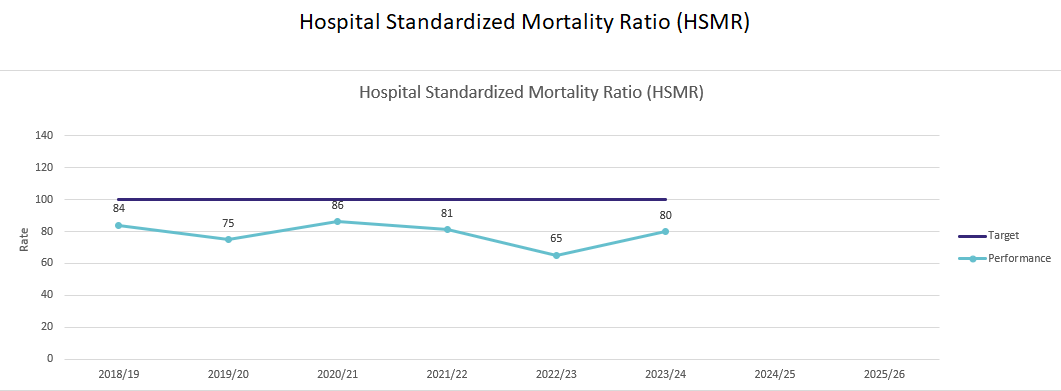The Brant Community Healthcare System is committed to providing exceptional, high-quality care, for all patients.
As part of our commitment to quality and patient safety, we continuously monitor the quality of care we provide using a number of evidence-based patient safety indicators. These indicators are standardized provincially and/or nationally as defined by the Ministry of Health and Long-Term Care, the Institute for Healthcare Improvement, the Canadian Institute for Health Information and Accreditation Canada.
The indicators relate to:
| Clostridium Difficile Infection (CDI) rate |
|

| Indicator Name: |
Hospital-Acquired Clostridium Difficile Infection (CDI) |
| Indicator Description: |
The indicator measures the incidence rate of hospital acquired Clostridium difficile infection (CDI) per 1,000 inpatient days. |
| Performance Direction: |
A lower rate is associated with better performance. |
| Quality Dimension: |
Safe |
| Indicator Type: |
Outcome |
| More Information: |
Health Quality Ontario: C. Difficile Infections Acquired in Hospital |
|
| Methicillin-Resistant Staphylococcus Aureus (MRSA) rate |
|

| Indicator Name: |
New hospital-associated methicillin resistant staphylococcus aureus (MRSA) bacteremia rate per 1,000 patient days |
| Indicator Description: |
This rate represents the incidence rate of nosocomial MRSA infection associated with the reporting facility per 1,000 inpatient days. |
| Performance Direction: |
A lower rate is associated with better performance. |
| Quality Dimension: |
Safe |
| Indicator Type: |
Outcome |
| More Information: |
Health Quality Ontario: Hospital-associated methicillin resistant staphylococcus aureus (MRSA) |
|
| Vancomycin-Resistant Enterococci (VRE) rate |
|

| Indicator Name: |
New hospital-associated vancomycin resistant enterococcus (VRE) bacteremia rate per 1,000 patient days |
| Indicator Description: |
This rate represents the incidence rate of nosocomial VRE infection associated with the reporting facility per 1,000 inpatient days. |
| Performance Direction: |
A lower rate is associated with better performance. |
| Quality Dimension: |
Safe |
| Indicator Type: |
Outcome |
| More Information: |
Health Quality Ontario: Hospital-associated vancomycin resistant enterococcus (VRE) |
|
| Central Line-Associated Primary Blood Stream Infection (CLI) rate |
|

| Indicator Name: |
Central Line-Associated Primary Blood Stream Infection (CLI) Rate |
| Indicator Description: |
The indicator measures the number of intensive care unit (ICU) patients with new central line-associated primary blood stream infection per 1,000 central line days. |
| Performance Direction: |
A lower rate is associated with better performance. |
| Quality Dimension: |
Safe |
| Indicator Type: |
Outcome |
| More Information: |
Health Quality Ontario: Central Line-Associated Primary Blood Stream Infection |
|
| Ventilator-Associated Pneumonia (VAP) rate |
|

| Indicator Name: |
Ventilator-associated Pneumonia (VAP) Rate |
| Indicator Description: |
This indicator measures the number of ICU patients with ventilator-associated pneumonia (VAP) per 1,000 ventilator days. |
| Performance Direction: |
A lower rate is associated with better performance. |
| Quality Dimension: |
Safe |
| Indicator Type: |
Outcome |
| More Information: |
Health Quality Ontario: Ventilator-associated Pneumonia (VAP) |
|
| Surgical Site Infection (SSI) Prevention rate |
|

| Indicator Name: |
Surgical Site Infection (SSI) Prevention (Hip and Knee Replacement) |
| Indicator Description: |
This indicator measures the percentage (%) of total primary hip/knee replacement surgical patients with antibiotic administration that starts an appropriate time prior to skin incision and is fully infused before the surgery begins. |
| Performance Direction: |
A higher percentage is associated with better performance. |
| Quality Dimension: |
Safe |
| Indicator Type: |
Process |
| More Information: |
Health Quality Ontario: Surgical Site Infection (SSI) Prevention |
|
| Surgical Safety Checklist (SSC) compliance |
|

| Indicator Name: |
Surgical Safety Checklist Compliance. |
| Indicator Description: |
This indicator measures the percentage (%) of surgeries in which a surgical safety checklist was used. The surgical safety checklist is considered to be completed when the designated checklist coordinator confirms that surgical team members have implemented and or addressed all of the necessary tasks and items in each of the three phrases, ‘briefing’, ‘time out’ and ‘debriefing’, of the checklist. |
| Performance Direction: |
A higher percentage is associated with better performance. |
| Quality Dimension: |
Safe |
| Indicator Type: |
Process |
| More Information: |
Health Quality Ontario: Surgical Safety Checklist |
|
| Hand Hygiene Compliance |
|

| Indicator Name: |
Hand hygiene compliance among health care providers. |
| Indicator Description: |
This indicator measures the percentage of hand hygiene compliance by health care providers before and after initial patient or patient environment contact. |
| Performance Direction: |
A higher percentage is associated with better performance. |
| Quality Dimension: |
Safe |
| Indicator Type: |
Process |
| More Information: |
Health Quality Ontario: Hand Hygiene Compliance |
|
| Hospital-Standardized Mortality Ratio (HSMR) |
|

| Indicator Name: |
Hospital Standardized Mortality Ratio (HSMR) |
| Indicator Description: |
HSMR is a ratio of the actual number of in-hospital deaths in a region or hospital to the number that would have been expected based on the types of patients a region or hospital treats. |
| Performance Direction: |
A lower ratio is associated with better performance. |
| Quality Dimension: |
Effective, Safe |
| Indicator Type: |
Outcome |
| More Information: |
Canadian Institute for Health Information: Hospital Standardized Mortality Ratio (HSMR). |
|




